Suillus grevillei (Klotzsch) Singer - Larch Bolete
Phylum: Basidiomycota - Class: Agaricomycetes - Order: Boletales - Family: Suillaceae
Distribution - Taxonomic History - Etymology - Identification - Culinary Notes - Reference Sources
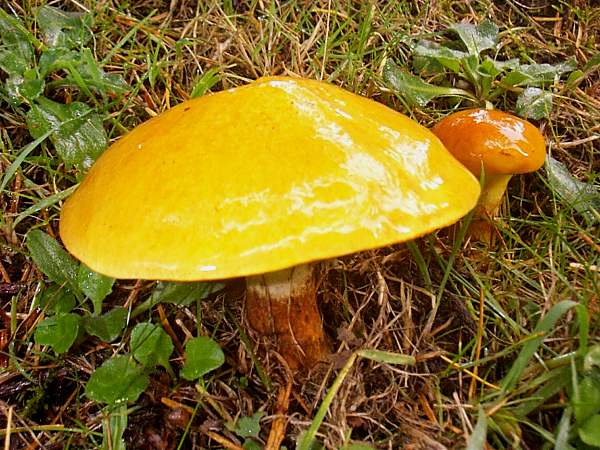
One of the most abundant of the Suillus species in the British Isles, the Larch Bolete appears in parks during summer and autumn. A woolly white veil covers the pores of young specimens.
Distribution
Very common in grassland under larch trees in Britain and Ireland, the Granulated Bolete is also found throughout most of mainland Europe. This bolete is also recorded in many parts of North America.
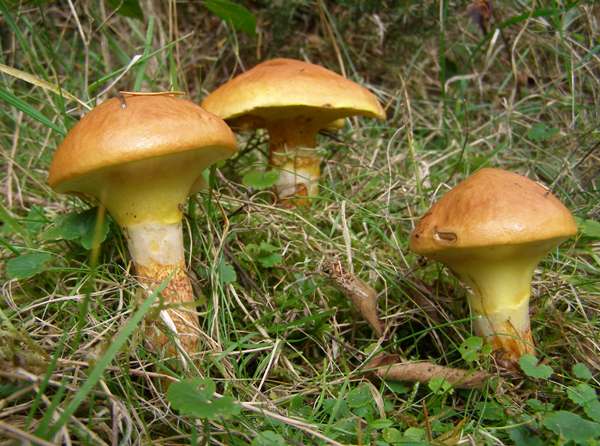
Taxonomic history
When German botanist-mycologist Johann Friedrich Klotzsch (1805 - 1860) described this species in 1832 he created its basionym when he gave this boletoid fungus the binomial scientific name Boletus grevillei. In 1945 Rolf Singer established the currently-accepted scientific name as Suillus grevillei.
Synonyms of Suillus grevillei include Boletus annularius Bolton, Boletus elegans Schumach., Boletus grevillei Klotzsch, Ixocomus flavus var. elegans (Schumach.) Quél., Ixocomus elegans f. badius Singer, Suillus elegans (Schumach.) Snell, and Suillus grevillei f. badius (Singer) Singer.
Etymology
The generic name Suillus means of pigs (swine) and is a reference to the greasy nature of the caps of fungi in this genus.
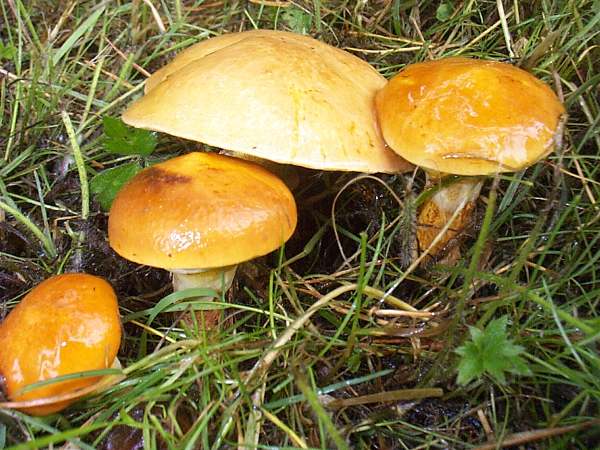
The specific epithet of this very common bolete is named in honour of the Scottish botanist/mycologist Robert Kaye Greville (1794 – 1866), whose academic career was paralleled by an interest in all aspects of the natural world and an exceptional talent as a botanical and landscape artist.
Suillus species are generally far more gregarious than other boletes, and Suillus grevillei is no exception; often the Larch Bolete creates lines or arcs of ten or more fruitbodies, with a succession of mushrooms over several weeks.
I have seen what appear to be fairy rings of this common woodland-edge and parkland mushroom, but always they are beneath larch trees because they are obligately mycorrhizal. This means that the fungus mycelium and the tree roots exchange nutrients to the mutual benefit of both organisms.
Identification Guide
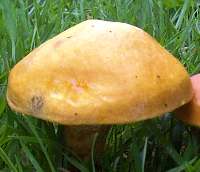 |
CapVariously coloured pale yellow, daffodil yellow, bright chrome yellow or bright rusty yellow, the cap of the Larch Bolete is very viscid when wet and remain shiny even in dry weather. 4 to 12cm across at maturity, and expanding until almost flat (occasionally conical or with a marked raised central area, known as an umbo), the caps of large specimens of this conspicuous bolete are quite often somewhat wavy at the margin. |
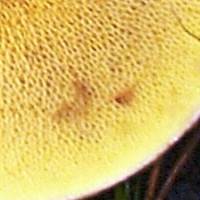 |
Tubes and PoresAt first lemon yellow, the angular pores take on a cinnamon tint as the fruiting body matures. When bruised, the pores (left) turn rusty brown. The tubes are pale yellow and do not change colour when the cap is cut. |
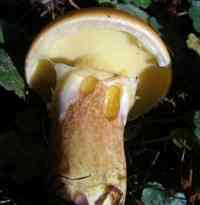 |
Stem1.2 to 2cm in diameter and 5 to 7cm long, the stipe provides a useful identifying feature: the thin white veil that covers the tubes of immature fruiting bodies forms a transient ring of the stem. When the ring falls away a pale area is left on the stem. Most of the stem is covered in brown dot-like scales; but above the ring zone the stem is often paler and almost scaleless (not so in the specimen shown here!). |
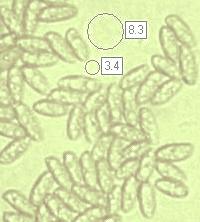 |
SporesSubfusiform, smooth, 8-11 x 3-4μm. Spore printOchre or sienna-brown. |
Odour/taste |
Not distinctive. |
Habitat & Ecological role |
Beneath larch trees, with which Suillus grevillei is ectomycorrhizal. |
Season |
July to October in Britain and Ireland. |
Similar species |
Suillus granulatus is quite similar but has no stem ring. |
Culinary Notes
Although considered edible, this is not one of the finest of boletes, which is a shame because often it fruits in great numbers. The cap skin and tube layer are usually removed and only the firm cap flesh used for culinary purposes.
Some people find that Suillus fungi cause them stomach upsets, and so if you do decide to gather Larch Boletes, Slippery Jacks or any other kind of Suillus mushrooms it is advisable to peel the caps, remove the tube layer, cook them thoroughly, and even then, as with any kind of edible mushroom that you are trying for the first time, have only very small portions until you are sure that you do not have an adverse reaction. (Personally, I don't collect any Suillus species because so many other superior mushrooms fruit over much the same period.)
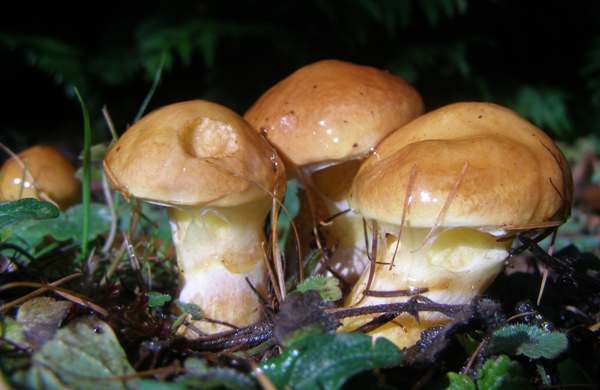
Reference Sources
Fascinated by Fungi, 2nd Edition, Pat O'Reilly 2016, reprinted by Coch-y-bonddu Books in 2022.
British Boletes, with keys to species, Geoffrey Kibby (self published) 3rd Edition 2012
Roy Watling & Hills, A.E. 2005. Boletes and their allies (revised and enlarged edition), – in: Henderson, D.M., Orton, P.D. & Watling, R. [eds]. British Fungus Flora. Agarics and boleti. Vol. 1. Royal Botanic Garden, Edinburgh.
BMS List of English Names for Fungi
Dictionary of the Fungi; Paul M. Kirk, Paul F. Cannon, David W. Minter and J. A. Stalpers; CABI, 2008
Taxonomic history and synonym information on these pages is drawn from many sources but in particular from the British Mycological Society's GB Checklist of Fungi.
Fascinated by Fungi. Back by popular demand, Pat O'Reilly's best-selling 450-page hardback book is available now. The latest second edition was republished with a sparkling new cover design in September 2022 by Coch-y-Bonddu Books. Full details and copies are available from the publisher's online bookshop...

